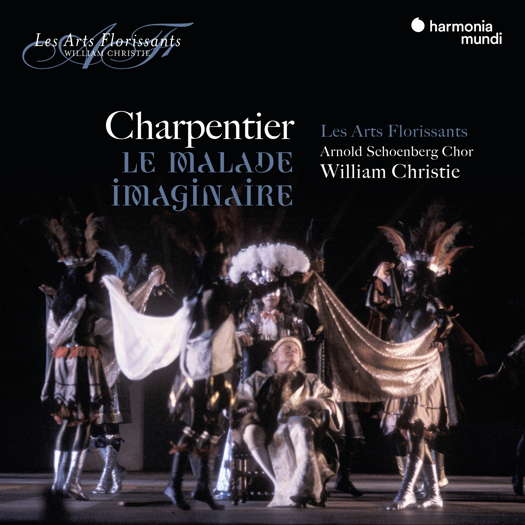 SPONSORED: DVD Spotlight. Olympic Scale - Charles Gounod's Roméo et Juliette, reviewed by Robert Anderson.
SPONSORED: DVD Spotlight. Olympic Scale - Charles Gounod's Roméo et Juliette, reviewed by Robert Anderson.
All sponsored features >>
- Ketil Hvoslef
- Alessandro Corbelli
- Johann Baptist Strauss
- Karl Jenkins Music Ltd
- Philharmonia Ltd
- Louise Reichardt
- Ray Nowak
- Hailey Fuqua
 DISCUSSION: What is a work? John Dante Prevedini leads a discussion about The performing artist as co-creator, including contributions from Halida Dinova, Yekaterina Lebedeva, Béla Hartmann, David Arditti and Stephen Francis Vasta.
DISCUSSION: What is a work? John Dante Prevedini leads a discussion about The performing artist as co-creator, including contributions from Halida Dinova, Yekaterina Lebedeva, Béla Hartmann, David Arditti and Stephen Francis Vasta.

An Interesting History
GERALD FENECH listens to Marc-Antoine Charpentier's 'Le Malade Imaginaire'
'William Christie and his Arts Florissants offer an interpretation that sparkles with a musical originality ...'
Le Malade Imaginaire by Marc-Antoine Charpentier (1643-1704) has an extremely interesting history which tends to raise eyebrows at how it ever came to be. On 10 February 1673, only a few months after their first collaboration, Jean-Baptiste Poquelin, better known as Molière (1622-1673), and Marc Antoine Charpentier presented at the Palais Royal's Theatre, Le Malade Imaginaire, a comedy with incidental music in the form of interludes built around a secondary plot. At the request of Molière, who expected the first performance to take place at court in Versailles, Charpentier composed a very developed prologue entitled 'Églogue en musique et en dance' (Eglogue in music and dance), similar to the prologues which were to precede the lyrical tragedies of Lully, combining solo recitative and choruses in praise of Louis XIV.
Listen — Charpentier: Ah! quelle douce nouvelle (Le Malade Imaginaire)
(CD1 track 3, 1:17-1:50) ℗ 1990-2013 harmonia mundi musique sas :
Le Malade Imaginaire is the last play by Molière, who died during the fourth performance on 17 February 1673. As a genre, the comedie-ballet was invented by Molière and Lully in the 1600s and reached a climax with Le Bourgeois Gentilhomme in 1670. But the dispute between the two (at the end of 1671), following the King's musician being granted a monopoly for all dramatic productions with music in Paris – including those of Molière – led the playwright to approach another composer, recently returned from Italy, and who had not yet written any music for the stage. Charpentier was the perfect choice.
Listen — Charpentier: Ouverture (Le Malade Imaginaire)
(CD1 track 1, 0:01-0:48) ℗ 1990-2013 harmonia mundi musique sas :
The composer revised the score at least twice in 1673 and 1685 to meet the constraints imposed by the royal monopoly accorded to Lully and the 'Academie royale de musique' which, after April 1673, held exclusive rights for all dramatic performances with music at the Palais Royal. These restrictions meant that Charpentier had to limit the number of singers and instrumentalists involved in each performance. Nonetheless, Le Malade Imaginaire is an absolutely endearing piece, full of engaging musical invention and dramatic punch that has retained its freshness for nearly 350 years.
This reissue was recorded way back in 1990, but time has not diminished its many attributes. William Christie and his Arts Florissants offer an interpretation that sparkles with a musical originality, which for Charpentier's time was regarded as too advanced. The singing is not only impressive, but has also a glorious aura of freedom and joie de vivre that is typically French.
Listen — Charpentier: Combat. Air de violons (Le Malade Imaginaire)
(CD1 track 6, 0:00-0:43) ℗ 1990-2013 harmonia mundi musique sas :
We have to keep in mind that this comedie-ballet was composed during a time of extravagance, when Louis XIV reigned in splendour and decadence. When first issued, this version attracted attention beyond the ordinary.
Listen — Charpentier: Air des révérences (Le Malade Imaginaire)
(CD2 track 6, 5:29-6:24) ℗ 1990-2013 harmonia mundi musique sas :
I think that this reappearance will cause the same stir, and deservedly so. If you missed the bus first time round, be sure to grab this second chance. It's really worth it.
Copyright © 29 October 2021
Gerald Fenech,
Gzira, Malta

CD INFORMATION - CHARPENTIER: LE MALADE IMAGINAIRE


